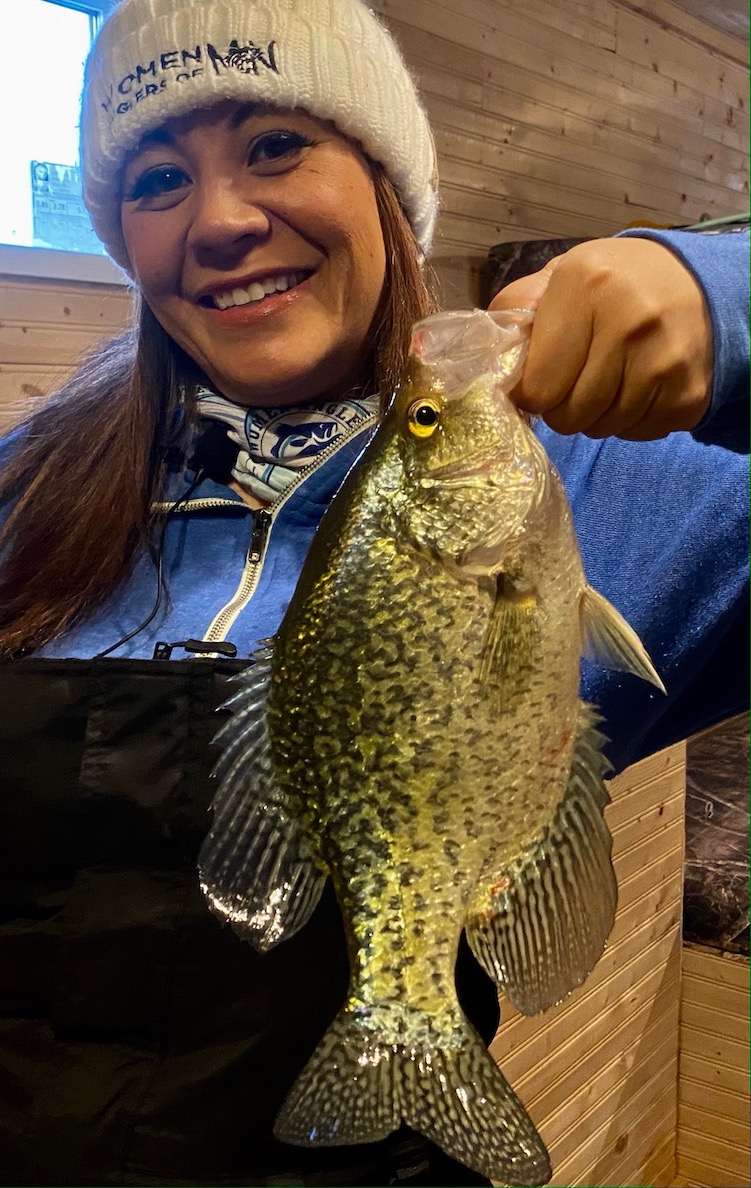Late Ice is Panfish Time!

Late Ice Panfish
There’s still time!
By Mike Frisch
As we enter the last few weeks of winter, some anglers have already stowed their ice fishing gear and are preparing for open water. That may be a mistake, particularly for those anglers who enjoy catching panfish like crappies and bluegills. Right now, these fish are vacating some of the deep basins they called home during mid-winter and moving back shallow. And, most importantly, they often have one thing on their minds: finding food!
A key to catching late ice panfish is staying on the move searching for active fish. Fortunately, late winter is a great time for searching as the weather is often nice meaning an angler can move around and drill lots of holes looking for fish while enjoying some of the coming spring’s first warm days.
When searching to find late ice panfish, I usually target the mouths of bays that are known to hold feeding and spawning bluegills and crappies later in spring. The fish often start to stage on the drop-off edges leading into these bays during late ice, anticipating spring and open water.
I drill holes on these edges looking for fish and the presence of weeds, especially green weeds showing life. Green weeds along a drop-off adjacent to a shallow bay can be the proverbial “spot on the spot” for late ice panfish.
Crappies and gills in these areas can often be caught in good numbers utilizing a pretty simple fishing set-up. A small tungsten jig fished on light line and tipped with waxworms or a small plastic bait is my “go to” rig at this time.
Tungsten jigs are denser than lead jigs meaning they fish “heavier.” A small profile, yet heavy jig “crashes” through slush in the fishing hole as well as any weeds encountered on the way to the fish. And, because panfish often come through in schools, another advantage of tungsten jigs is that their quick fall rate quickly gets them back down to the remaining fish after one has been caught.
My favorite tungsten jigs are the Drop Jig and Drop Jig XL. These jigs come in several sizes, a variety of good colors, and have “sticky” hooks. The Drop tipped with a couple waxworms has been very productive. However, spring panfish often love small Maki plastics on jigs and that’s where the Drop XL with its bigger hook really shines.
Most days during spring, I’ve been able to catch more fish tipping with plastics. The fish really seem to like the added action of a quivering plastic and several fish can often be caught on the same bait, meaning I spend more time fishing and less time re-baiting!
My rod and reel set-up for fishing small jigs consists of a spring bobber rod and reel loaded with 3-pound line. The ultra-light Scepter Stick spring bobber rod I use does a nice job of letting me know when I get bit, yet has the power needed to pull scrappy panfish from the weeds.
A final essential gear item needed is a good winter sonar unit. The Vexilar flashers I use have great target separation. Target separation when fishing panfish in the weeds is very important because it lets me identify, and target, individual fish in a school from other fish and from the weeds as well.
Experiencing good ice fishing action yet this season is very possible. Heading to a good panfish lake and using some of the tips provided here just might, in fact, help you get in on some of the year’s fastest fishing action right now!
And, as always, remember to include a youngster in your next outdoors adventure.
Mike Frisch hosts the popular Fishing the Midwest TV series. Visit www.fishingthemidwest.com to see all things Fishing the Midwest.
Photo – Stephanie Lawson of the Women Anglers of Minnesota with a big crappie she caught in February. Crappies and bluegills move shallow in March and provide great fishing opportunities at “last ice!”

